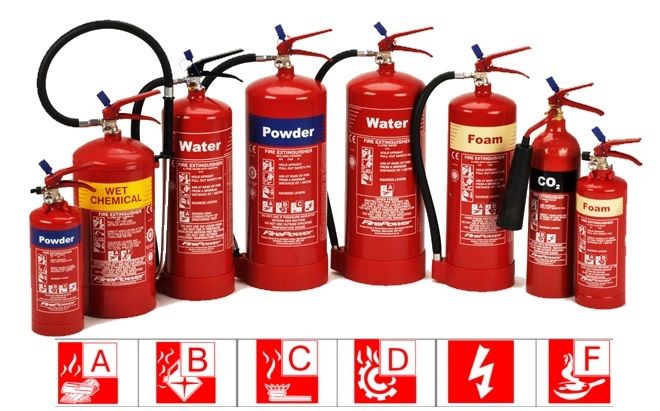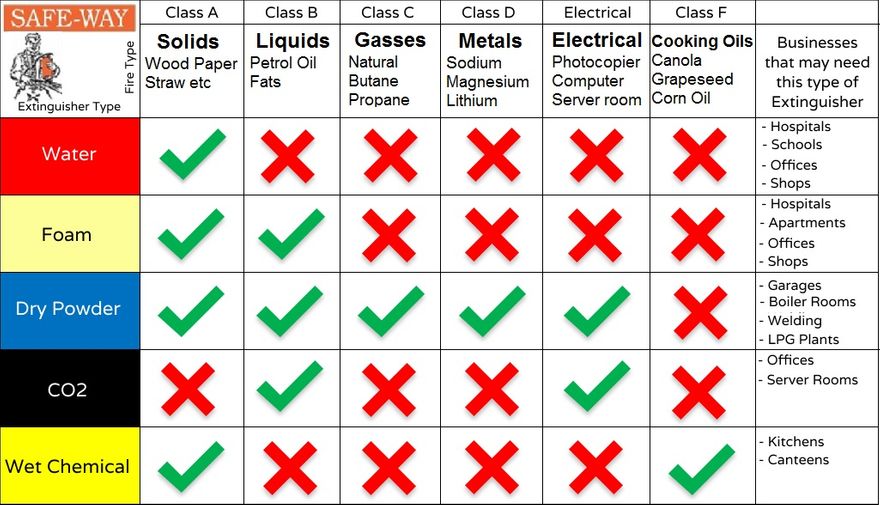Which Extinguisher for Which Fire
What types of Fire Extinguisher are available
There are 5 main types of extinguisher on the market at the present time
Water - Foam - Dry Powder - CO2 and Wet Chemical
To ensure you are adequately protected and you conform to current fire safety regulations and requirements, it is essential you have the right extinguisher for the risk in the right place.
In the U.K and across Europe, we identify types of fire by different classes using letters A - F as follows:
Class A - These are what we call Solid fires consisting of materials such as Wood, Paper, Straw, Textiles
Class B - Petrol, Oils, Paints and Spirits, or Waxes, Polishes & Fats that are solid to begin with but will revert to their liquid state when heated.
Class C - Gasses, LPG, Butane, Propane, Methane.
Class D - Metals, not often thought of as flammable fire risk`s but some metals can be, Sodium, Potassium, Lithium.
Electrical Fires - This is not strictly a Class as in (Class E) because Electricity is more a source of ignition rather than a fuel. However, fires in or involving live Electrical equipment, are an additional hazard. One thing we dont want is you using water or any other conductor where live electrical equipment or possible high capacity charge is stored or present.
Electrical fires are not given their own full class, as they can fall into any of the classifications. After all it is not the electricity burning but surrounding material that has been set alight by the electric current. The Fire Safety Advice Centre - Fire Extinguishers
Making sure Electrical installations are installed correctly then inspected and maintained at recommended intervals will reduce the chances of this type of fire happening.
Class F - (Cooking Oils & Fats) Class F fires differ from flammable liquid fires as in liquids like petrol have low flash points and low auto-ignition temperatures but cooking oils & fats require temperatures in excess of 300 °C to ignite.
Because of that high temperature, the trade has come up with an extinguisher called the Fryfighter or the Wet Chemical.
These extinguishers have been specifically developed to tackle fires involving cooking oils and fats and contain potassium salts which both cool the flames and smother the fire's oxygen content by a process called Saponification which cools and smothers the burning liquid.
Class B variations
When dealing with Class B flammable liquids, there are variations as in the fire risk could be Hydrocarbon or it may be Polar Solvent, the easy way to differentiate is just to tell you that Polar Solvent fires are alcohol based.
AFFF Foam on Alcohol based fires are not effective as the Alcohol tries to absorb water from the foam blanket being laid down causing it to collapse and disappear until the fuel is fully exposed again, to counteract this we use AR-AFFF, this is an Alcohol Resistant fire fighting foam that lays down a blanket of foam the alcohol doesnt affect, during manufacture, a high molecular weight polymer is added to the AFFF Foam that then forms a physical membrane (Polymeric Barrier) between the fuel and the foam, that barrier then protects the foam blanket from destruction by the alcohol.
Advice
Any business is entitled to buy their equipment cheaper from all the internet sales sites, however, these still need to be commissioned by a certificated professional in case of damage in transit and some need basic assembly that the non- professionals miss.
It should be stated that if you are not really sure about which extinguisher you require for which risk and where it should be located, it will always be better to seek the advice of a trained Engineer/Technician to ensure not only conformity but more importantly, operator safety.
Dry Powder Recommendation In British Standards
B.S 5306-8/2012 : 5.4.3
Use Of Powder Extinguishers
(The discharge of a powder extinguisher within buildings can cause a sudden reduction of visibility and can also impair breathing, which could temporarily jeopardize escape, rescue or other emergency action. For this reason, powder extinguishers should generally not be specified for use indoors, unless mitigated by a health and safety risk assessment).
How Many Extinguishers Do You Need
British Standard B.S 5306 - 8/ 2012 (Fire extinguishing installations and equipment on premises. Selection and positioning of portable fire extinguishers. Code of practice) defines the formula for working out the quantity and positioning of extinguishers required to protect a building. Note: Your Fire Risk Assessment will also play a part in covering any possible Fire risk.
As a general rule one extinguisher with a Fire rating of 13A covers 200 square meters which is calculated by multiplying the floor area by 0.065.
Example (200 x 0.065 = 13, then we add the A for Class A material (wood, paper, textiles, carpets, desk`s etc) leaving us with a 13A Fire rating.
If the extinguisher covers (flammable liquids) it will have a B rating, Class B ratings are given depending on how many litres of flammable liquid the extinguisher can put out under test conditions, an extinguisher such as a 2kg CO2 carries a 34B rating, this informs us the extinguisher will deal with 34 litres of flammable liquid. Some extinguishers such as Foams have a combined Fire rating which may state 13A/144B, this extinguisher deals with more than one risk and will cover 200m2 and 144 litres.
The higher the numbers on an extinguisher, the bigger the fire it can deal with.
The latest published version of BS 5306-8/ 2012 advises that each storey with a floor area less than or equal to 400m² should have at least 2 extinguishers and these should have a minimum combined Fire rating of 26A.
For any storey with a floor area exceeding 400 m² the A rated extinguishers should have a combined minimum fire rating of 0.065 x floor area of the storey (in square metres). In basic terms, for every additional 200m² you require an extra 13A extinguisher.
Additional Extinguishers or Fire Blankets to cover electrical risk, Flammable stores, Kitchen fryers or any potential Fire risk may also be required and will be stated in the Fire Risk Assessment or advised by a competent person.
Use the area calculator below to work out the floor area of a room.
Monthly Extinguisher Checks
British Standards, BS 5306 pt3-2017 are the standards applied to the Supply, Installation & Servicing of extinguishers and state as follows:
11.2
Instructions for visual inspection
The competent person should advise the responsible person to carry out visual inspections of all extinguishers at regular intervals.
This advice should include the following instructions.
a) These visual inspections should be carried out at least once a month.
When circumstances require, inspections should be carried out more frequently. NOTE 1 Fire legislation ([1] to [3]) and its associated Guidance Notes suggest that good practice is to determine whether the extinguisher has been operated and to check for damage on a monthly basis.
b) When carrying out these visual inspections, it should be ensured that:
1) each extinguisher is correctly located in its designated place;
2) each extinguisher is unobstructed and visible;
3) the operating instructions of each extinguisher are clean and legible and face outwards;
4) each extinguisher has not been operated and is not obviously damaged or has any missing parts;
5) the reading of any pressure gauge is within the green zone;
6) any indicator fitted to an extinguisher is within operational and safety limits;
7) the tamper indicators of each extinguisher are not broken or missing.
c) The responsible person should record the results (e.g. in a fire logbook) of these visual inspections and arrange for corrective action, where necessary, by a competent person. In the event of doubt, the responsible person should arrange for a competent person to examine the extinguisher. NOTE 2 Responsible persons have obligations under fire legislation ([1] to [3]) to ensure that extinguishing equipment is maintained in an efficient state, in good working order and in good repair.
FIRE LOG BOOK
Should you require a Fire Log book for the recording of not only extinguisher checks but other fire safety equipment in your premises, and the frequencies you should be checking them to assist and ensure your legal compliance under the Fire Safety Order, you may download a free version by visiting Dorset & Wiltshire Fire Authority site such as below and scrolling down to:
Fire Safety Inspections and Maintenance Log Book
or the Hampshire & Isle of Wight Fire Authority site and scrolloing to Fire Safety Log Book in the link below


